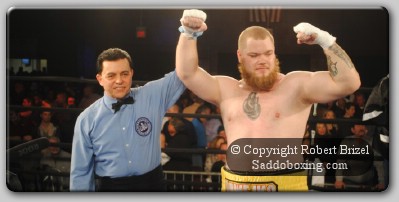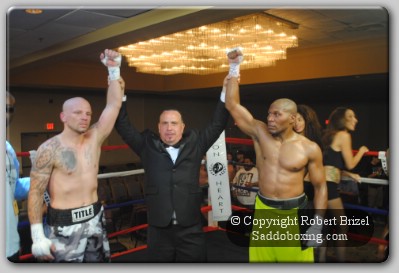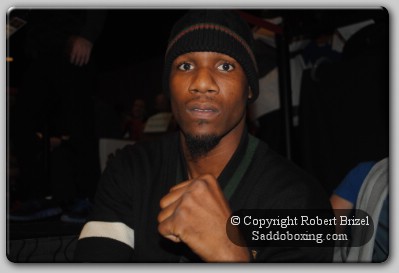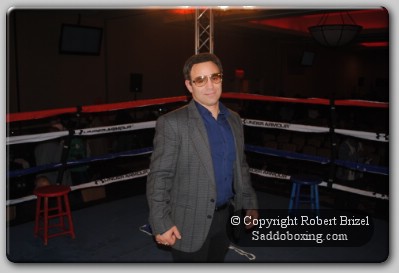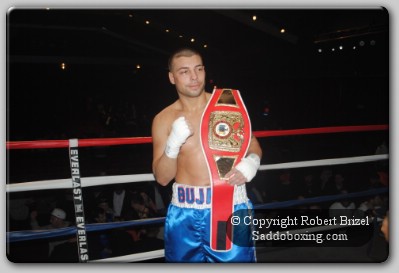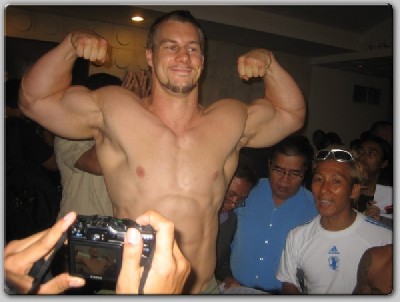
© Mark De Mori
The heavyweights were once the glamour division of boxing but in recent years has come under harsh criticism for lack of talent, excitement and a true unified champion. Eastern European heavyweights currently dominate the division and the U.S. are pushing their best candidates forward with Eddie Chambers and Chris Arreola hoping they can get a piece of the alphabet titles.
The heavyweight division is in desperate need of new talent, a young fighter that can come up the ranks and be entertaining to watch. Enter Mark “The Dominator” De Mori from Perth , Australia . He’s a 27 years old orthodox fighter, 6’2”, 233 lbs and at first glance looks more like a body builder than a boxer, but don’t let his muscles fool you because in addition to his dominating right he can box well and is able to get very low as he bobs and weaves his way forward.
Admittedly De Mori was a one dimensional fighter early in the pro ranks, dominating his opponents most by knockout, but after suffering a knockout loss he took some time off to become a more complete fighter. The time off and on the job training has worked well for “The Dominator” as he improved his record to 15-1-2 (13).
SaddoBoxing had the privilege to get an exclusive interview with De Mori to get a closer look at this up and coming heavyweight.
Saddoboxing: I read that you became interested in boxing at the age of 15 after watching Mike Tyson defeat Frank Bruno in their second fight, you said you were then hooked on the sport and switched from Australian Football to boxing; what was it about Tyson that hooked you on the sport?
Mark De Mori: “He was so powerful and looked like a modern day gladiator; the fans reaction to everything he did was incredible. I am a fan of boxing but more a fan of heavyweight boxing, because they are the biggest and baddest.”
SB: You turned pro after only 11 amateur fights due to limited competition, did you consider trying to make the 2004 Olympic team?
MDM: “I fought at 75kg, 81kg and 91kg, retiring at the age of 19 having lost interest, I was never good enough to make the Olympics and I never really cared about it, to me pro boxing was the only style that mattered and in my state pro boxing was dead.”
SB: The heavyweight division has been criticized for a lack of exciting fighters, what do you feel you can bring to the division?
MDM: “I’m not an overweight giant that clinches any chance I get, I can box or bang and I think a heavyweight with skills is awesome to watch; watching two lumbering giants that only throw the same jab, cross over and over, and then hold is boring.”
SB: You experienced a 1st round KO loss in your first year as a pro, what went wrong during that fight? What did you learn from it?
MDM: “What went wrong is my opponent continually hit me in the head! I was not in the right place mentally to be fighting and I had much to learn. I learned from that fight, I needed to go back to the beginning and learn so much more about the game, previously I had just bowled everyone over with pure strength.”
SB: Was there something specific that caused you to not be mentally prepared for the fight?
MDM: “I was not happy where I was living or training, I was fighting so regularly and not resting injuries that I was totally burnt out, it was my 4th fight in like six or seven weeks. I felt like a zombie walking into that ring. I didn’t feel like boxing then or for the next few months, basically I started to hate the sport.
“In a funny way being knocked out was kind of good for me mentally because I knew I could have a break, but before I knew it I was sparring again and nothing changed so I just decided to give it away for some time. In those days I didn’t really understand the dedication I would need to be a top fighter and even though I was winning nearly every fight by KO I knew I had some huge holes in my game that needed work.”
SB: After that fight it was 17 months before you stepped back in the ring, did you consider walking away from the sport?
MDM: “For some time I hated everything to do with the sport, I was burnt out, I realized I was simply needed a break and for some time I hardly boxed, but eventually the hunger came back. I moved back to my home town and started training for fun, let my injuries heal and got a phone call from manager Ted Allen and I have enjoyed the sport and training ever since.
“Ted knew I had learning to do so we didn’t rush, I have learnt on the job. Unlike some fighters who have hundreds of amateur fights and come to the pro game ready made fighters, I had to learn as I went and there was huge room for improvement.”
SB: The biggest name on your pro resume is Ed Mahone who is a veteran who has shared the ring with Vitali Klitschko, Eddie Chambers and Alexander Povetkin, how did that fight compare to your other opponents? What was it like to step up to face someone with that type of ring experience?
MDM: “Ed was easily my toughest test on paper and I knew I would have to improve to beat him, but being a fan of his I knew how he fought and how to beat him, I watched his fights so many times I knew what he was going to throw before he did, I formulated a plan and new style to beat him and it was a fantastic fight for my confidence, I don’t think I got hit cleanly more than twice the whole fight, I worked so hard on my defense for that fight.”
SB: After the Mahone fight you used that performance to impress U.S. promoter Don King, why did you feel it necessary to find a U.S. promoter?
MDM: “Because there is no money in Australian boxing unless you are a celebrity boxer like so many former rugby players are here. I didn’t go to bed at night dreaming of fighting for peanuts at the local basketball hall, I went to bed dreaming of fighting in the big Vegas arenas for millions, so it was only natural I focused on the USA . Thanks to my sponsor Alan Burns and my manager Ted Allen it’s now becoming a reality.”
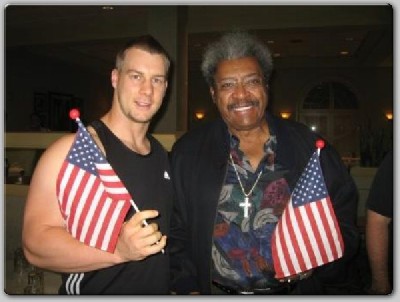
© Mark De Mori
SB: Is it difficult to fight in the U.S. while residing in Perth ? Is there any advantage of relocating to the U.S. ?
MDM: “It’s not ideal living in Perth but I do my best to make it work, I have fought outside of my own country seven times and often traveling without a trainer or team. I’m used to it now it doesn’t bother me; I just get on with the job.
“Starting with my fight with Richard Tutaki in Jakarta , I have really improved; I have got my weight lower and my strength and conditioning much, much higher. I put it down to working much harder at my game and nothing else, Ted saw the improvements and that’s when we knew I was ready for the next level.”
SB: At the end of 2008 you signed a three year contract with Don King and have fought twice under his moniker, and climbed to a WBC ranking of 20, what’s next for you?
MDM: “Well I’m hoping for a big fight, I do not intend to try and work my way up the rankings like some pretend fighters do, I want to fight well known proven fighters that will give me the experience to make it at the top.”
SB: I had the opportunity to watch some of your fight clips on YouTube and was impressed with your punching power, in addition I noticed that you seem to have a habit of keeping your left hand low brining your jab up towards your opponent rather than snapping it straight out. Is there a specific strategy behind this method?
MDM: “I fight much better with this style, many traditionally trained fighters and coaches hate it, but my favorite fighter James Toney does it and it has been working for me, I watch hours of him and other similar fighters trying to emulate them. It gives me much more agility and I get hit much less.”
SB: There are some rumors of a potential match-up with Davarryl Willisamson; is that a fight that is in negotiation?
MDM: “Nothing final but it would be a good test for me, I saw him fight live against Carl Davis and he impressed me, I always knew he could fight but seeing him live was different, so it’s a fight that will force me to improve and up my game to new level.”
SB: Another fellow Australian fighter Kali Meehan has had some success with Don King, have you ever considered fighting him to find out the best Heavyweight in Australia ?
MDM: “Another good fight for me, I sparred him once years ago; Kali is waiting for a shot at Valuev for big money so I doubt we will fight soon.”
SB: For the boxing fans that haven’t had the chance to see you fight how would you describe your style of fighting? Is there any fighter that you feel you emulate?
MDM: “I’m versatile, against Mahone and Kooser I was a boxer with movement, against Barnett I changed to be a come forward body puncher. Basically I watch my opponent and decide which style will hurt him most then train like that for the fight.
“I also only allow myself to watch fighters who have a similar style. I love watching James Toney, Pernell Whitaker, Prince Naseem, Nicolino Locche, Floyd Mayweather and Chris Byrd; I try to only watch the skillful guys to learn from them, I have fast reflexes and feel I can use their moves.”
SB: Thank you for taking the time for this interview, I wish you the best of luck in your career.
MDM: “Thank you.”
 Boxing News Boxing News
Boxing News Boxing News
